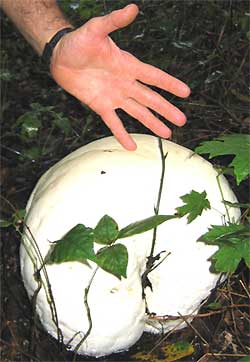Excerpts from Jim Conrad's
Naturalist Newsletter
from the October 6, 2006 Newsletter, with notes from a recent visit to Kentucky's Bluegrass Region, USA
A GIANT PUFFBALL
 About a week before I left Polly's Bend in central Kentucky some friends from Oregon came for a visit. We took a walk through the secondary woods behind the old farmhouse in which I was staying and we came upon a Giant Puffball, CALVATIA GIGANTEA, which was about a foot across and pure white. One of my visitors, Christie, carried a digital camera. The image she took finally has made its way to me, so you can see it at the right.
About a week before I left Polly's Bend in central Kentucky some friends from Oregon came for a visit. We took a walk through the secondary woods behind the old farmhouse in which I was staying and we came upon a Giant Puffball, CALVATIA GIGANTEA, which was about a foot across and pure white. One of my visitors, Christie, carried a digital camera. The image she took finally has made its way to me, so you can see it at the right.
You'll see from the hand next to this puffball that this is a pretty substantial item. Though this one is about as large as any I've encountered in the wild, I've seen pictures of them much larger. It's not terribly uncommon for them to reach 18 inches across, and I've read reports of their growing to three feet and weighing 47 pounds.
An aggravating feature of our finding this mushroom was that it is considered "choice" in terms of edibility. If you find a big one and don't want to collect the whole thing you can even slice off what you need, the puffball stops growing but doesn't begin decaying or going bad, and you can keep slicing meals off it until you've had all you want!
What's aggravating is that we found this puffball fairly soon after I'd been poisoned by that Green-spored Parasol, and just thinking of eating another mushroom, even one definitely highly edible, tied my stomach in a knot. I let the puffball alone and suppose it grew even larger before its deliciously soft, dry interior -- its "spore mass" or "gleba" -- dried into inedible, powdery spores that escaped through its shattered walls.
In fact, all North American puffballs are considered edible, with the possible exception of one species, which produces a purple spore mass when young. Just don't eat any puffball whose spore mass isn't white and soft feeling.
Some poisonous mushrooms, such as the deadly amanitas, pass through an early "button stage," when they can look like puffballs. However, when such buttons are cut in half they reveal a typical mushroom shape inside, so that you know you don't have a real puffball.